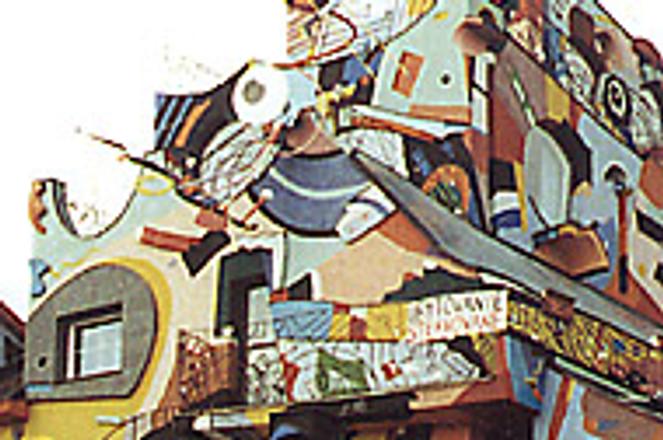The café on the bottom floor serves food according to patron blood types.photo: Ján Svrček
Greta Jajcajová lives in a black apartment. And today the 35-year old brunette is dressed head to toe in black.
"Maybe I'm compensating for my work environment," she jokes.
Jajcajová's work environment is a four-story, 1,000 square metre labyrinth of 35 colours that she and her colleagues built over seven years. Located behind Bratislava's main train station, the rainbow collision of architecture and art was finished late last summer.
"We don't have a name for it yet," says Jajcajová, who refers to the building simply as "the object". "Some people call it the 'smiling house' or the 'abstract house'."
The building is the brainchild of Karol Beláň, a 45-year old engineer who believes that abstract art has beneficial effects on human personality. He says his building will be the site of a university of "personality development", where students will "develop their inner beings" with the goal of becoming more "effective people". The five-year study programme would include a wide range of subjects such as alternative medicine, metaphysics, and meditation.
"It should take us about one year to start the university," says Beláň. "We have to petition for accreditation from the Slovak government, secure professors and find a person who would help us with a loan."
Situated behind the Bratislava main train station, the colourful house has a café and rooms for rent.photo: Ján Svrček
For now, the building's facilities are being put to alternative use. A first floor restaurant, open daily ten to ten serves food - both "meat and rational dishes", says Jajcajová - according to diners' blood types. The second floor lecture hall is the sight of English lessons and personality development courses for professionals. The third floor "Spirit Hotel" sleeps 23 in eight rooms.
All rooms encompass the abstract art style visible from the outside.
"The main goal was for people to feel good while they are in the building," says Jajcajová. "It's not possible not to feel good here."
Leading a tour - into the fourth-floor meditation room with it's pyramid shape, onto the roof to see the multicoloured chimney - Jajcajová explains that after the building was finished she and Beláň went through it and pencilled the abstract designs. Later they coloured in the lines.
"The art doesn't have concrete meaning," says JajcajovŠ, gesturing at a wall in the dining room. "But if you look at these circles coloured in pastels, for example, they should give you a feeling of freedom."
BelaÚ, who has not studied psychology formally, has dedicated much of his life to the science of personality development, and more recently to abstract art, which he says is a key tool in promoting spiritual harmony and personality development.
Although not all neighbours are pleased with the incongruous house, most say it doesn't "bother" them.photo: Ján Svrček
"When you step into this environment where abstract art dominates, you automatically feel a greater sense of freedom, dynamism, and harmony," he says.
But some neighbours get different feelings from Beláň's work.
"It's a mess," shouted Peter Macháč from a third-story window of a house that his family has owned for three generations. "Such a building has no business in a residential district. People live away from the city centre for relaxation, not to see this."
Macháč said he watched helplessly as the project slowly grew over seven years. "They never had permission for this. It was only supposed to be one floor, but it just kept getting bigger."
Beláň admits to building on the sly. "Since it was an atypical idea we couldn't get permission for it as a whole. We had to work on it in individual sections."
Most neighbours have a more tolerant view than Macháč.
"It's not pretty, but it doesn't bother me. People should be able to build whatever they want," said Slávka Baligová, life long neighbourhood resident.
"I am not for or against the building," adds Miloš Horár, who's lived nearby for 40 years.
Jajcajová says that most who come visit the building react positively. "People may say that we're crazy, or that we're a sect that wants money. But once they come, relax and see that we don't want anything from them, they usually like it."
Jajcajová is proud of the building she helped create, but says she will keep her black apartment.
Beláň, on the other hand, often sleeps in his seven-year opus. Has living there helped his personality?
"Not yet," he laughs. "But maybe in a year or two when the university is running I'll start to see improvements."


